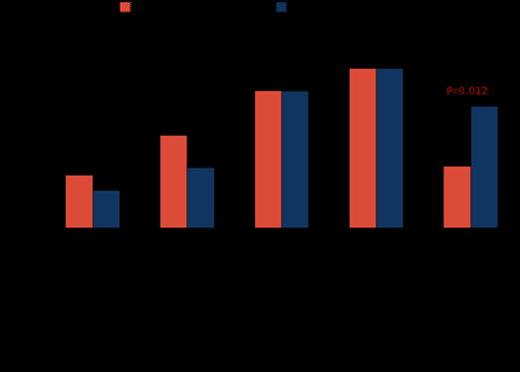Thrombotic thrombocytopenic purpura is often associated with a severe congenital or antibody mediated deficiency of ADAMTS13. The wider availability of the ADAMTS13 activity assay has led to it being used to aid in making treatment decisions. However, a proportion of patients with clinically diagnosed TTP who respond well to plasma exchange do not have severe ADAMTS13 deficiency. We studied a cohort of 57 patients with TTP to compare the presenting features and clinical outcomes of patients with and without severe ADAMTS13 deficiency.
We identified a cohort of 57 patients treated for TTP at the Cleveland Clinic between 2000 and 2012 who underwent testing for ADAMTS13 activity prior to transfusion of blood products or initiation of plasma exchange. Clinical and laboratory data were gathered from their medical records. Fisher exact test was used to compare categorical variables and the T-test was used to compare continuous variables between patients with and without severe ADAMTS13 deficiency defined as undetectable (<5%) activity.
Thirty six (63%) of 57 patients had severe ADAMTS13 deficiency while the remaining 21 (37%) has ADAMTS13 activity ranging from 8% to 56%. Of the 36 patients with severe ADAMTS13 deficiency, 28 had idiopathic TTP while 8 had secondary TTP. For patients with detectable ADAMTS13 levels there were 12 and 9 patients with idiopathic and secondary TTP respectively. There was no significant difference in the clinical setting (idiopathic versus secondary TTP) (p=100), age (p=0.190) or sex distribution (p=0.362) between patients with and without severe ADAMTS13 deficiency.
Patients with and without severe ADAMTS13 deficiency had heterogeneous clinical presentations which were not significantly different with comparable rates of fever (p=0.555), neurological symptoms (p=0.140), anemia (p=0.203) and thrombocytopenia (0.223). However, patients with detectable ADAMTS13 activity had higher rates of renal impairment at presentation (34% versus 72%, p=0.012) and higher mean serum creatinine at presentation (3.23±2.55 versus 1.94±2.21, p=0.009).
Both groups of patients had similar rates of response to plasma exchange, mortality (p=0.620) and relapse (p=1.000). However patients with detectable ADAMTS13 activity had significantly worse renal outcomes than patients with severe deficiency with higher rates of acute renal failure needing dialysis [Relative Risk (RR) 2.89, 95% CI 1.66-5.05), progression to chronic renal insufficiency (RR 2.86, 95% CI 1.37-5.96) and end stage renal disease needing dialysis (RR 3.12, 95% CI 2.11-4.61).
Patients with and without severe ADAMTS13 deficiency have similar presenting features and clinical outcomes (mortality and relapse). Patients with detectable or normal ADAMTS13 activity have worse renal outcomes (acute renal failure, chronic renal insufficiency). At least some of these patients may have an alternative form of thrombotic microangiopathy such as atypical hemolytic uremic syndrome (aHUS) and may be candidates for earlier evaluation for aHUS and possible complement directed therapy.
Presenting features and outcomes of patients with and without severe ADAMTS13 deficiency (n=57)
| . | ADAMTS13<5% (n=36) . | ADAMTS13>5% (n=21) . | P value . |
|---|---|---|---|
| Age >60 | 4 (11.11) | 6 (28.57) | 0.190 |
| Female sex | 24 (66.7) | 17 (81) | 0.362 |
| Idiopathic TTP Secondary TTP | 28 (77.8) 8 (22.2) | 12 (57.4) 9 (42.9) | 0.100 |
| Fever | 12 (33.3) | 5 (23.8) | 0.555 |
| Neurological symptoms (Seizures, focal deficits, obtundation) | 21 (58.3) | 8 (38.0) | 0.140 |
| Outcomes Death Relapse Acute renal failure Chronic kidney disease End stage kidney disease | 2 (5.6) 6 (16.7) 2 (5.6) 2 (5.5) 0 (0) | 2 (9.5) 4 (19.0) 8 (38.1) 5 (23.8%) 4 (19.0) | 0.620 1.000 0.003 0.028 0.015 |
| . | ADAMTS13<5% (n=36) . | ADAMTS13>5% (n=21) . | P value . |
|---|---|---|---|
| Age >60 | 4 (11.11) | 6 (28.57) | 0.190 |
| Female sex | 24 (66.7) | 17 (81) | 0.362 |
| Idiopathic TTP Secondary TTP | 28 (77.8) 8 (22.2) | 12 (57.4) 9 (42.9) | 0.100 |
| Fever | 12 (33.3) | 5 (23.8) | 0.555 |
| Neurological symptoms (Seizures, focal deficits, obtundation) | 21 (58.3) | 8 (38.0) | 0.140 |
| Outcomes Death Relapse Acute renal failure Chronic kidney disease End stage kidney disease | 2 (5.6) 6 (16.7) 2 (5.6) 2 (5.5) 0 (0) | 2 (9.5) 4 (19.0) 8 (38.1) 5 (23.8%) 4 (19.0) | 0.620 1.000 0.003 0.028 0.015 |
Presenting features of patients with TTP with severe ADAMTS13 deficiency (ADAMTS13 activity <5%) and detectable ADAMTS13 activity (ADAMTS13 activity >5%).
Presenting features of patients with TTP with severe ADAMTS13 deficiency (ADAMTS13 activity <5%) and detectable ADAMTS13 activity (ADAMTS13 activity >5%).
Clinical outcomes of patients with TTP with severe ADAMTS13 deficiency (ADAMTS13 activity <5%) and detectable ADAMTS13 activity (ADAMTS13 activity >5%).
Clinical outcomes of patients with TTP with severe ADAMTS13 deficiency (ADAMTS13 activity <5%) and detectable ADAMTS13 activity (ADAMTS13 activity >5%).
No relevant conflicts of interest to declare.



This feature is available to Subscribers Only
Sign In or Create an Account Close Modal